

 HOME | ÍNDICE POR TÍTULO | NORMAS PUBLICACIÓN
HOME | ÍNDICE POR TÍTULO | NORMAS PUBLICACIÓN  Espacios. Vol. 37 (Nº 29) Año 2016. Pág. 7
Espacios. Vol. 37 (Nº 29) Año 2016. Pág. 7
Gustavo Bernardi PEREIRA 1; Adriana De Paula Lacerda SANTOS 2
Recibido: 26/05/16 • Aprobado: 12/06/2016
ABSTRACT: This paper aimed to describe and analyse the development and deployment of an educational tool that addresses topics such as waste, costs and optimization. This is done by a board game called DECOT. This game simulates the products – most of them textiles - crafted by the “production agents” and uses the way the pieces are allocated on the board to assign score, penalties and benefits. The board game’s major objective is the increase of the entrepreneurship and production capabilities of the involved people, resulting in a reduction of the production costs. The used methodology in this research was the research-action, applied directly in the groups already organised by FAS. The research results show that the developed tool could be added to other actions along the groups and help to achieve economic autonomy of the supported citizens. Furthermore, there will be an increase in the group self-esteem, turning them more united and motivated. |
RESUMEN: Este trabajo pretende describir y analizar el desarrollo y la implementación de una herramienta educativa que aborda temas como residuos, costos y optimización. Esto se hace por un juego de mesa llamado DECOT. Este juego simula los productos, la mayoría de los textiles - hecho a mano por los "agentes de producción" y utiliza la forma de que las piezas se asignan en la tabla para asignar puntaje, sanciones y beneficios. Los objetivos principales del juego de mesa es el aumento de las capacidades de emprendimiento y producción de las personas implicadas, resultando en una reducción de los costes de producción. La metodología utilizada en esta investigación fue la investigación-acción, aplicada directamente en los grupos ya organizados por FAS. Resultados de la investigación muestran que la herramienta desarrollada se podría añadir a otras acciones a lo largo de los grupos y ayuda a lograr la autonomía económica de los ciudadanos admitidos. Además, habrá un aumento en la autoestima del grupo, convirtiéndolos más Unidos y motivados. |
In many developing countries, numerous families find themselves in a troublesome situation regarding their health and finances. As example, according to the 2010 Brazilian National Census, Brazil has 25% of its population earning about US$60,00 per month and about 50% earning up to US$120,00. The minimum wage at the time of study was US$160,00 per month (IBGE, 2011).
A considerable part of the low waged slice also has another complicating: the low level of education. In Curitiba (south of Brazil), the portion of low educated people (illiterate of who did not finish basic education) in 2010 was 2.1% of the population (about 220 thousand inhabitants) (IBGE, 2010).
The autonomous search for an alternative income form often results in poor working conditions and low financial return. In this context, the actions in the social field have their point of action, since a significant portion of them has the goal of dealing with poverty (OLIVEIRA, 2008).
The presence of institutions for this purpose (social action) has been shown to be beneficial to the community of the region of Curitiba - city analysed in this research. The public agency responsible for managing the social assistance in the city is called FAS (Curitiba Social Action Foundation). It operates in an integrated manner to government agencies and NGOs that make up the social assistance network in the city (FAS, 2013).
Efforts are scoped the consolidation of social assistance in the city, according to the guidelines of the Unified Social Assistance System (SUAS) - public system that organises social assistance services in Brazil. The Ministry of Social Development and Fight against Hunger does the coordination of this system. In the range of Curitiba, FAS operates in a decentralised manner, organised in nine regional centres present in the city (Bairro Novo, Boa Vista, Boqueirão, Cajuru, CIC, Matriz, Pinheirinho, Portão e Santa Felicidade).
Preferably geared to citizens, groups and families who find themselves at risk and social vulnerability, the services are organised into levels of social protection: basic and special.
Basic protection comes to matters relating to the provision of services aimed at socialising and family and / or community life. Its social protection focuses on families and individuals whose rights have been violated and have their family ties either broken or weakened. Both services are available in the categories of medium and high complexity.
The field of Endeavor of the social-action covers professional training and development of entrepreneurs, providing courses in different areas and integration workshops. These courses and workshops are developed in the Professional Qualification Centres (Liceus de Ofícios), in CRAS and elsewhere, which are made available by agreed partnerships.
There are 29 Professional Qualification Centres and the skills developed there intended to improve the participants’ employability. These improvements are done while maintaining the priority on the most socially vulnerable because, in this way, the process contributes to their autonomy and increase in the family income.
The CRAS (Reference Centre for Social Assistance) are the implementing units of basic protection services. The services and activities aim to prevent risk situations, strengthening the role of the family as a reference to each of its members and the strengthening of its internal and external links.
Within the services offered by CRAS, the one that is noteworthy in creating income-generating opportunities issues called Social Showcase Program (Vitrine Social).Its goals to instigate new alternatives for growth and generation of employment and income through the creation of handmade products and / or services, enhancing the social actions continuity. Families served by CRAS are invited to participate in social and educational activities that seek to raise awareness of the development of personal entrepreneurial characteristics. Representatives, over 16 years, of these families compose the groups, and they are offered new challenges to be prepared for the opportunities offered by the market (VITRINE SOCIAL, 2013).
The maturity in the development cycle is reached by the group when it conquests autonomy and emancipation of the services offered by CRAS, by the results from the sale of its products. In sum: Vitrine Social acts aiming to encourage the rescue of its members’ dignity and value as a citizen as well as trying to provide a better quality of life.
However, because of the low education of the group members, there is a substantial difficulty in solving some issues encountered during the process.
At this point, it was glimpsed a possibility of establishing a partnership between University and FAS. Some students (from several courses) of the State University of Paraná (UFPR)integrate a research group called GESIT (Technological Innovation Study Group) which, among its various projects, has a program so-called Production in Focus.
Started in 2010, the program’s objective is to create a mutual learning space where students of the Production Engineering could exchange experiences with those involved in Local Productive Arrangements (APLs). These arrangements are groups that produce handcrafted products to be sold in specific fairs and use the money raised by sales as an income increase. The project is educational in the sense that the students of Production Engineering have the opportunity to apply the knowledge and techniques learned in the lectures. This out of Academy use enables the generation of employment and extra income for those involved. The mutual learning configures a win-win relationship as the APLs have a private production orientation and the students have the opportunity of having field studies.
Thus, the UFPR contributes with the education of production engineers showing concern with social aspects at the same time the government is contributing to the creation of jobs and income for people in situations of risk and social vulnerability.
The entrepreneur is the one who proposed to try (a laborious and difficult business) (FERREIRA, 1999). When opting for a more applied bias, the entrepreneur can be seen as "the one who has the willingness to dare, to challenge conventional wisdom, to take risks and confronting uncertainties”.
Still in an entrepreneurial approach, Dornelas (1999) the classification of an entrepreneur is an "eminent opportunities identifier". Dornelas (1999) highlights elements an entrepreneur definition should include:
Entrepreneurs, regardless of the niche in which they are (either a large corporation or a small business owner), pay taxes, wages, interest, rents and supplies, generating and distributing wealth and increasing the standard and quality of life.
The volume of the wealth created by the companies is directly proportional to the increase in the standard and quality of life. Not surprisingly, the most prominent standard of living and quality of life in the world manifest in those societies where entrepreneurship is more active (MAXIMIANO, 2011).
Social entrepreneurship differs in two aspects with respect to entrepreneurship itself: it does not produce goods and services to sell, but to solve social problems; and it is not directed to markets, but for segments of the population in social risk situation (social exclusion, poverty, misery, life threatening) (MELO NETO, 2002).
According to Decroly and Monchamp (2003), social entrepreneurship has the role of modifying agents in the social sector by:
Educational games are not an end itself, but a step that is part of the set of active pedagogy procedures. Moreover, when used as a means of demonstration, educational games constitute a "lesson", although illustrated, is as appropriate as most classical lessons (DECROLY, MONCHAMP, 2003).
Games give the teacher the opportunity to observe the students’ performance in the course of development and allow the students themselves to integrate the evaluation process: evaluating the companions and self-evaluating. The self-assessment presence makes their participation becomes more responsible, helping them to take responsibility and to decide which criteria are most important (ALMEIDA, 2003).
The work can be classified as an action research, which has the intention to play an active role in the observed reality itself. Action research is the procedure with empirical basis that is designs and carries out in close association with an action or with the resolution of a collective problem in which researchers and representative participants of the situation or the problem are involved in a cooperative or participatory way (THIOLLENT, 2007).
In terms of methodology, there was a survey conducted by an approach essentially qualitative. According to Dyniewicz (2009) this type of approach is the one that emphasises the dynamic, holistic and individual aspects of human experience. This work uses as base instruments interviews, questionnaires and observation. Regarding the investigation way, the research can be classified as explanatory, whose approach aims to identify the factors that contribute to the occurrence of phenomena or variables that affect the process. For better organisation of the work, the research was divided into six stages, as shown in Figure 1 .
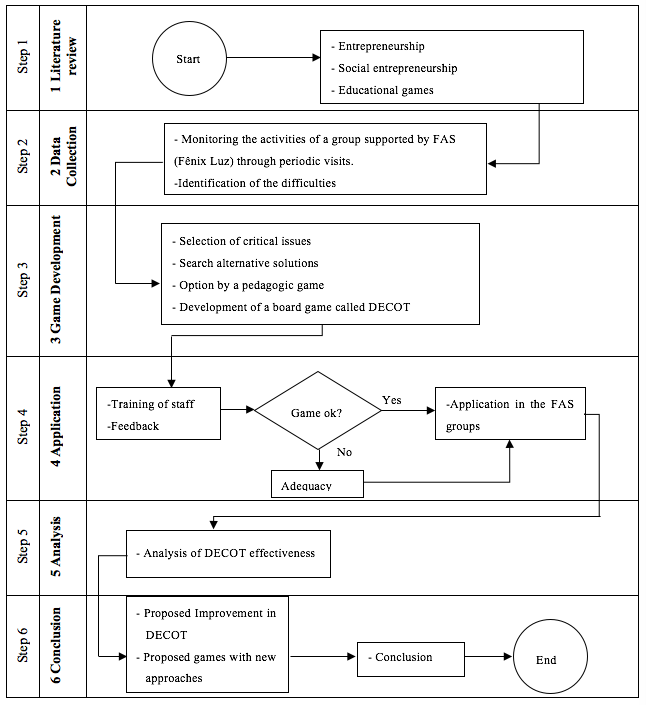
Figure 1 - Methodological procedures
The first stage consisted in a literature review of the two major topics addressed in this paper: Social Entrepreneurship and Educational Games. In each topic, it is shown its concept, so that these concepts were later applied in the development, application and analysis stage.
Then, there was made the exposure of how the data collection was made in a group served by Vitrine Social: a group called Fênix da Luz. The data collection took place through measurements of the workstations and interviews with group members. These data have provided data for the identification of critical issues in the production process.
After identified such issues, the search for alternative solution started. Several options were considered before the adopted option: an educational game called DECOT (waste, costs and Optimisation).
With DECOT already structured, training was given to the FAS’ facilitators, collecting evaluation and suggestions by using a questionnaire [Appendix A]. After analysing the results, it was possible to identify and correct some details before applying the FAS groups.
Some applications were made with the groups served by Vitrine Social with the use of another specific questionnaire that sought to analyse some aspects of the game from the production agents’ standpoint. Finally, the questionnaires were attached to the information gathered throughout the process and it was made a global analysis of DECOT creation and implementation.
The work will be better detailed in the steps suggested by Thiollent (2007) in an action research; they are Exploratory Phase, Diagnosis, Action Phase and Evaluation Phase.
The first stage of work is the exploration of the research development environment - the FAS’ group Fênix da Luz. This group consists of four women that handcraft fabric products to external marketing. The manufacture of these products is financed by the own members (equipment and materials), which have their own physical production space.
For understanding of their activities and the way they work, periodic visits were made to analyse various factors, such as the workplace, physical and financial limitations, as well as educational and cultural levels.
From these visits, it was noticed that the group faced problems when it came to sewing time optimisation and the costs measurement. Because of this, a comparative analysis of the manufacturing steps of three products (tooth book, ‘fuppet’ – a puppet for fingers - and the 'corner' bag, shown in Figure 2 was performed. This analysis showed that the major cost-benefit was in the production of the 'corner' bag. It was then, made the suggestion to adopt it as the ‘lever product’, prioritising its production volume to generate a higher return and thus eventually subsidise the production of other products.

Figure 2 – Tooth book, “fuppet” and ‘corner bag’, respectively
With these results, was considered the possibility of developing away to implement a tool that could allow the team a learning experience regarding the optimisation of their production time and measuring their costs in order to manufacture their products more profitably and with less waste.
Furthermore, this proposal would not only bean one-off performance in a FAS group, but sought to pass this learning to all FAS groups with the same job profile, seeking a broader spectrum of activity.
From the established proposal in the Diagnosis, it was decided to develop a board game that could teach the FAS social assistants concepts relating to waste, cost measurement and optimisation. Then a search was made to find playful tools that could serve as a basis for the game, so that the Tangram has been identified as a viable alternative. At that point, there was a possibility of incorporation of the methodology adopted for the identification and analysis of processes and costs made in Fênix da Luz. This incorporation related especially to the product considered with the biggest cost-benefit for the process: the ‘corner’ bag.
Associating a board game with a fabric roll used to create the products, it was possible to define the guidance for the game dynamics. This guidance defined the way the board game would deal with concepts of Waste, Costs and Optimisation – resulting in its name: DECOT (in Portuguese Desperdício, Custos e Otimização).
As the game should be able to teach – in a simple and straight way – the three concepts (aforementioned) concepts, a board was developed, simulating an unrolled roll of fabric, Figure 3. The products to be done would be taken from this piece of fabric. This board is a gradient matrix (it starts on green, passing through yellow and ending up on red) composed by triangles. This colour distribution inserts, unconsciously, the idea of the best pieces positioning – green is the best and red is the worst. The ruler in the bottom line intends to facilitate the point counting.
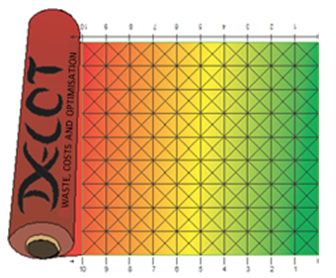
Figure 3 – DECOT’s Board
On the board are placed pieces representing parts of products (produced by FAS groups) in a geometrised way. They will be arranged on the board as a "puzzle” so that the game can make progress. Scores will be established according to the amount of waste presented by the items arrangement in each round.
To deal with the particular production factors - drawn from the study with several other FAS groups - playing cards were developed (Figure 4). These cards insert restrictions and/or bonuses for the round. The restrictions are for presenting real situations of everyday life that interfere negatively in the quality of production. On the other hand, the bonuses are for presenting some good points. Both the bonuses and restrictions have the role to make the rounds more competitive and dynamic.

Figure 4–DECOT’s deck cards
To create a "short-term file" to analyse and compare on how each team arranged the pieces on the board, primers were created (Figure 5). They serve so that each team can note the proportion of use/waste and visually identify their relation. This visualisation intends to facilitate the teaching process and provides a stronger argument in the way of learning why the parts must be arranged in one way or another. The primers also serve to ultimately make the recording of points and thus indicate the winner.
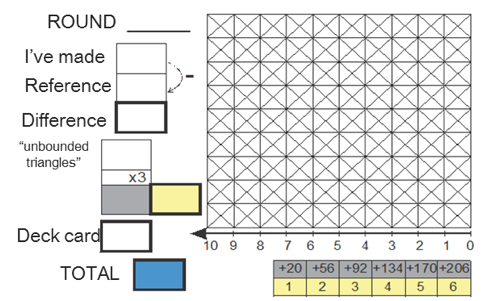
Figure 5– DECOT’s prime
DECOT composes of two independent and complementary games: "Waste" and "Optimisation and costs." For both games, it was found during the training sessions that FAS promotes that the ideal team players number is 3-4 members.
The "Waste" game should be the first stage of the DECOT dynamics and it is recommended to be played when the "production agents" find themselves in the early stages of FAS support program. At this stage, there will be awareness of the concept of waste reduction.
The game begins with the draw of the teams of about three members, managing to mix the most of the existing FAS groups. Once done, each team receives a board and some cards. It is recommended that teams are provided to a distance for a not interfere with the development of the other, looking for a unique effort by each team.
The instructions given to the teams, about how the game works, happen in three stages:
1º before the game starts should be explained to the teams that the board represents fabric in which the parts are cut;
2° by the end of the first round should be told that the closer to the green edge of the board, the better for the production (as spend less fabric, always starting from the idea that no one knows what will be produced then. This works as if there is a new fabric to the end of each set of pieces to be cut.
An important consideration to make is that the game assumes that it is unclear what the next piece to be cut is. It is possible that, depending on the group's products and being in a real situation, it is desired to leave the parts arranged in another way - leaving more space at the top or bottom area. By the end of the game, it is considered as if there was a restart of the fabric to be cut every round.
3a - At the end of the second round should be told the teams to the last form of score are given by the amount of the leftover triangles that are not connected to the roll of fabric, Figure 6.

Figure 6- The “unbounded triangle” are indicated in yellow
From there, the round starts. Following the order of the predetermined levels, the first round begins. Each team receives a card from the deck and a set of the corresponding parts at their level. Then the judge announces the start of the round.
The "judge" is a role that can be played by the FAS’ staff or even a production agent of ‘Vitrine Social’ with the ability to give fluency to the game. They have the role of instructing players during the game. The order of colours and their levels are shown in Table 1.
Table 1 – Game Stages
| Table 1 Stages and colour | ||
|
Name |
Colour |
1º |
Dog clothing |
Brown |
2º |
Bag |
Blue |
3º |
“Corner” bag |
Green |
4º |
T-Shirt |
Red |
5º |
Couch cover |
Yellow |
Initially it was thought in a predefined duration for each stage, however, a seach time DECOT is applied anew configurations of teams appear, there is great heterogeneity. However, it was left to the judges the definition of the duration of each step in.
At the end of each round each team shows their board with the chosen arrangement of the parts (Figure 7), as well as the card, got from the deck. Next, the team itself records the points-filling in the spaces corresponding to scores on the primer (Figure 8).
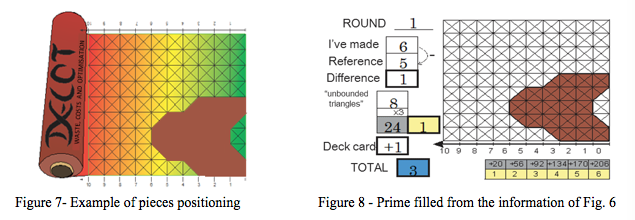
In the “I’ve made” field should be placed the number of columns used by the team. The “Reference” should contain the number indicated by the judge, as the reference value of the round. A booklet with the reference values is included in the game box and expresses a value equivalent to a good use of fabric. This booklet should not be revealed to the participants so that there is a constructive process of assembling parts and the participant can play more than once without being favoured.
Next, the field “Difference" is the result of the subtraction of the value in “I’ve made” minus “Reference”. It is possible that, in some cases, the difference is a negative value, meaning that the team was better than the suggested pieces positioning value. This is not a problem. The sum in the field “Total” should be made in the same way, just by adding a negative value.
To continue filling in the primer, the field “not connected” must be filled - which refers to the wasting score. Then the multiplication is made and the found value is used to locate the value in the table (printed in the primer). This table was defined according to information provided by members of FAS and tries to translate, in a numerical way, how many “unbounded triangles “are equivalent to the disposal of a fabric column. It has been found that 20 triangles would be a reasonable percentage of the column to consider (as each column has 36 triangles, 20 represent 56% of total). With this reasoning, it was possible to draw up the table, which gives 1 extra column to values over 20 triangles, 2 columns to 36 + 20 = 56 triangles and so on as there is an increase in the number of “unbounded triangles” found.
The last part of the score comes from the playing cards, which must be placed in the corresponding field. Finally, it is the sum of the fields with bold border for the final score.
In this final stage of the round the judge must examine the available options of parts made by the teams and, where necessary, to expose a better alternative. Once the rules are passed gradually along the three steps explained previously, in the first two rounds should only be those related to the fields filled with scores already explained.
In order to define a "winner", if there is interest of all - the judge and groups. Using the sum of the scores of each team and the winner will be whoever has the sum of the Lower Total field all the cards.
In a second moment, either the game “Optimisation and costs” can be used or not, this will depend on the needs of each supported group. Its application, when required, should occur in the intermediate stages of FAS’ support process. This application demands that the groups already have a greater maturity in producing the product. It serves to reduce the problems encountered up to this point - which involve scaling and accounting issues.
The development of this part is nearly the same as the first: many levels, same primer and the same form of punctuation. The main differences are:
This second contact with the game aims the awareness of the importance of design and reflection on the ideal size of products in order to avoid waste under the available conditions. This concern is illustrated in Fiure 9, where the piece was reduced slightly being possible the use of available space on the fabric for cutting two pieces instead of one.

Figure 9 – Pieces with different scaling to fit better in the available space
The differences from the game "Waste", the one that presents a real need - regardless of the group's production maturity level - is the calculation of the costs. Throughout the period of analysis of Vitrine Social groups, the costing was a challenge that concerned groups widespread, despite the courses run by FAS. It was necessary to think in a way that is simple and immediate so that the costs could be calculated (or at least approximated with a good margin of error). It was then developed the “cost primer” (Figure 10), which attempts to simplify the most of the method for calculating the costs.
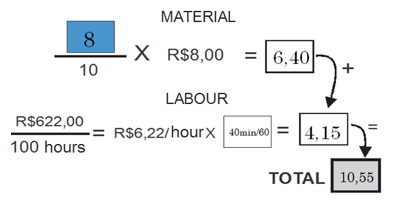
Figure 10 – Example of a filled Costs Prime
This primer has two sections: cost of materials and cost of labour. In first section, the sum of the fields total has to be converted into meters and it has to have the same unit for the calculation so it is divided by 10. It is assumed that the board has 10 columns representing 1 meter, therefore, each column represents 10cm. The taken value for the material in this game was the raw cotton’s - which cost is $ 8.00 per meter. With this information, the cost of material can be calculates.
When calculating the cost of labour, the fraction expresses the minimum wage at the time (date on the first work with the Fênix da Luz) divided by the total hours worked per month (20 days x 5 hours of daily work). From this, it is possible to obtain the value per hour of labour. This value, multiplied by the total employee time in creating the products results in the value of the labour. The total cost is the sum of the cost of material and labour.
Just as was done in the “corner bag”, the cost calculation considers only the material and labour, leaving aside the indirect costs of production.
Since the development of DECOT was completed, after a long period of conversation with FAS groups and staff, a formal application of the game was held in its final form with the members of GESIT and FAS. This application was meant to make adjustments if there was need. The application included 24 participants, 10 students of GESIT/UFPR and 14 members of the FAS team. At the time of the application of DECOT the Questionnaire I (Appendix A) was applied in order to determine various parameters pertaining to their level of difficulty, education level, adaptation to the environment and receptivity by the agents of production. The Questionnaire I was made by using grades 1-4, with 1 being the equivalent of NO and 4 equivalent to YES in order to have a gradual evolution. The questions were designed so that the options relate to the ease/adaptation of the game. The results are shown in Figure 11.
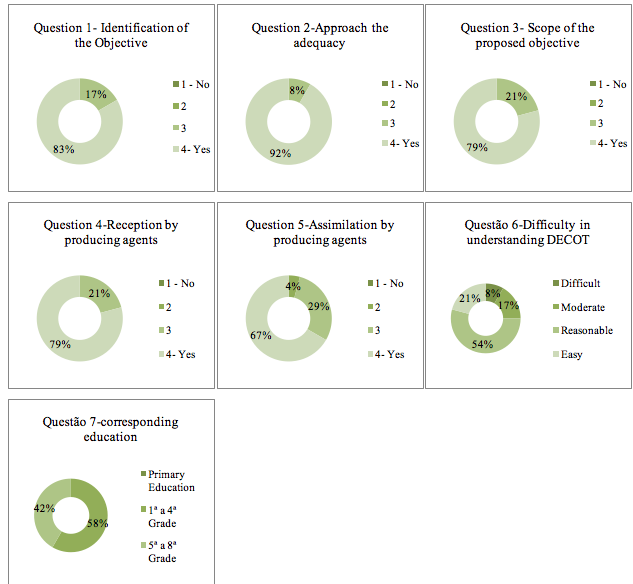
Figure 11- Results of Questionnaire I
After analysing the results, minor modifications were made concerning the mode of application. For the physical production of the game were used resources from the Program Production in Focus, granted by the Ministry of Education. The game was produced in cardboard and had a circulation of 200 units. It was completed in July 2013 and is now ready for distribution in the groups served by the Vitrine Social. Were then made four applications of DECOT in August and September 2013 in CRAS Santa Rita, Uberaba, Bairro Novo and Boqueirão, with the participation of 24 agents of production who came from various groups as well as the FAS members, responsible for CRAS. These applications were designed to draw a profile of the production of agents exposed to this new tool. Participants were asked to answer to the questionnaire II (Appendix B), that contains 4 questions about waste and quality products made from textile fabric. The first question, in a comprehensive and graphic form, presented positioning alternatives to cut a piece within a space corresponding to virgin tissue. The second question, presented possible changes to improve the use of the fabric. The third one showed points about the quality of the product. Finally, the fourth question briefly addressed the costing issue. The results are shown in Figure 12.
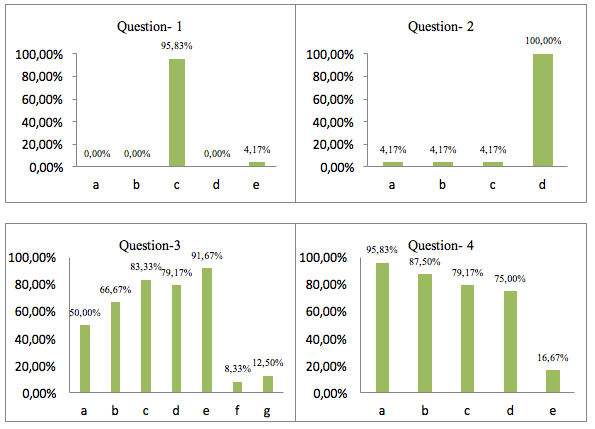
Figure 12- Results Questionnaire II
After DECOT has been played be the groups, as well as the questionnaires, it was possible to evaluate the game in a more comprehensive and consistent manner. Analysing the assessments made by the FAS members (Questionnaire I), the following conclusions are: The game features easy identification of the goal - in this case, the objective/purpose of the game is to facilitate the learning of issues relating to waste, costs and optimisation in the form of a board game.
The approach adopted was appropriate, given the context in which the production agents are and the situations faced routinely;
The goal attainment is possible, since such an approach facilitated the assimilation of the concepts that is to be inserted, because there was the identification with the everyday life with what is presented in DECOT;
Receptivity, by production agents in the sense of the “want to play” would be good. This perspective assumes the comparison made with other educational tools adopted by FAS;
In the case of incorporation of concepts learned effectively in production, there was also a positive outlook from the adoption of practices in the production environment;
The level of difficulty in understanding the rules and dynamics of the game was considered, in general, reasonable;
Finally, the education level considered adequate to take advantage of DECOT effectively was the primary (presenting a difference of opinion with respect to the grade)
Turning to the analysis to the other hand - the production agents – the conclusion from Questionnaire II are:
Almost all the involved were able to identify the position of the product to be cut in order to obtain the lowest possible waste generation;
Regarding the improvement in the use of fabric, it was very clear the behaviour that values the planning of positioning each piece before you start cutting;
On the issue of improving the use of the fabric, the courses offered by the FAS played an important role, but remaining points of doubt by the production agents. This statement bases on the fact that only 50% of respondents agree with the alternative “equal parts should have equal size”. Two other elements that confirm the presence of doubts are uncertainties regarding the influence of materials and tools on the final quality of the product. To a lesser extent, the association of the selling price with the product with its quality. The alternative “change the work environment”" - as was explained to the participants the dynamics - relates to the comparison of production made within FAS headquarters and production in the group's own space;
To calculate the amount spent with the production, almost all participants (95.83%) included the amount of fabric used. One in four participants dismissed the electricity costs and maintenance of equipment. The major problem encountered in the group Fênix da Luz (including the time spent in making the product in the final sale price) appeared in only one out of eight participants, which was considered a positive point in the courses provided by FAS.
From the results of the questionnaires, it is possible to conclude that this tool successfully fulfilled its role as interactive game – as well as easy to understand and to use by the FAS producing agents. The survey results also showed that the new tool could be used along other actions with the FAS groups. The game also could help to achieve economic autonomy of the citizens supported. Furthermore, it was possible to identify benefits that were generated during the development of this interactive game, by the students of GESIT, by FAS and, especially, by the community served by the project. These contributions can be seen in Table 2.
Table 2 - Benefits for the involved
Involved |
Role |
Benefits |
GESIT students |
Visiting the production places and giving advice to FAS groups. |
Possibility of applying Production Engineering concepts in a social context; Problem solving with lack of resources (especially low budget). |
FAS as organisation |
Providing social assistance in its various forms; |
Possibility of use of a unified tool for solving common problems - focusing on product quality and cost estimate; Increase in the group self-esteem, making them more united and motivated on their way to the emancipation from FAS. |
Community served by the project |
The people who was directly involved in the community were the agents of production and indirectly, people linked to the production of agents - that have participation in their lives; either related to the income factor or the personal factor. |
Increased monthly income; Facilitation of accounting; Product quality improvement; More transparency in the group's balance sheet (avoiding conflicts). |
To the Social Action Foundation of Curitiba (FAS) for the important work in the city social framework and the partnership throughout the project, the University Extension Program (PROEXT) that provided financial assistance throughout the project and the Ministry of Education (Mec) which made possible the physical production of this project.
IBGE. (2011). Indicadores Sociais Municipais 2010: incidência de pobreza é maior nos municípios de porte médio, 2011, Sala de Imprensa, Brasília, 16. nov. Notícias. Disponível em: <http://saladeimprensa.ibge.gov.br/noticias?view=noticia&id=1&busca=1&idnoticia=2019>. Acesso em 27/03/2015.
IBGE (2010). Censo Demográfico 2000/2010. Taxa de analfabetismo da população de 15 anos ou mais de idade, por grupos de idade, segundo as Unidades do Ministério do Desenvolvimento Social e Combate à Fome (MDS). Sistema Único de Assistência Social (SUAS). Disponível em: <http://www.mds.gov.br/assistenciasocial/suas>Acesso em 27/03/2015.
OLIVEIRA, E. M. (2008). Empreendedorismo social: da teoria à prática, do sonho à realidade. Rio de Janeiro: Qualitymark. 211 p., il. Inclui bibliografia. ISBN 9788573037456 (broch.).
FAZ (2015). Apresentação da FAS. Site Oficial da Fundação de Ação Social de Curitiba. Publicado em 25/01/2013. Disponívelem<http://www.fas.curitiba.pr.gov.br/conteudo.aspx?idf=44>Acessoem 27/03/2015
VITRINE SOCIAL (2013). Ações de geração de renda - Fundação de Ação Social de Curitiba. Publicado em 13/08/2013. Disponívelem<http://www.fas.curitiba.pr.gov.br/conteudo.aspx?idf=136>. Acesso em 23/08/2014
FERREIRA, A. B. de H.; ANJOS, M. dos; FERREIRA, M. B. (1999). Aurélio Século XXI: o dicionário da língua portuguesa. 3. ed. Rio de Janeiro: Nova Fronteira. xxxi, 2128. ISBN 8520910106 (enc.).
DORNELAS, J. C. A. (2001). Empreendedorismo: transformando ideias em negócios. Rio de Janeiro: Campus. 299p.,il. ISBN 8535207716 (broch.)
MAXIMIANO, A. C. A. (2011). Administração para empreendedores. 2. ed. São Paulo: Prentice Hall. 240 p., il., 24 cm. Inclui bibliografia e índice. ISBN 9788576058762 (broch.)
MELO NETO, F. de P. de; FROES, C. (2002). Empreendedorismo social: a transição para a sociedade sustentável. Rio de Janeiro: Qualitymark. 208p.,il. Bibliografia:p.201-204. ISBN 857303372x (broch.)
DEES, J. G. (2013). The meaning of social entrepreneurship. Social Enterprise Partnerships, 31 outubro 1998. Disponível em: <http://www.partnerships.org.au/library/the_meaning_of_social_entrepreneurship.htm>. Acesso em: 08/08/2013
DECROLY, Ovide; MONCHAMP, E. (1998). El juego educativo: iniciación a la actividad intelectual y motriz. 3. ed. Madrid: Morata. 182p.,il. Inclui bibliografia.
ALMEIDA, P. N. (2003). Dinâmica lúdica: técnicas e jogos pedagógicos. 11. Ed. São Paulo: Loyola.
THIOLLENT, M. (2007). Metodologia da pesquisa-ação. 15. ed. São Paulo: Cortez. 132 p. Inclui referências bibliográficas. ISBN 9788524911705 (broch)
DYNIEWICZ, A. M. (2009). Metodologia da pesquisa em saúde para iniciantes: sugestões e normas para trabalhos de conclusão de Curso de Graduação -TCCs e monografias de Cursos de Especialização. São Caetano do Sul: Difusão. 207 p., il. Inclui bibliografia. ISBN 9788578080501 (broch.)
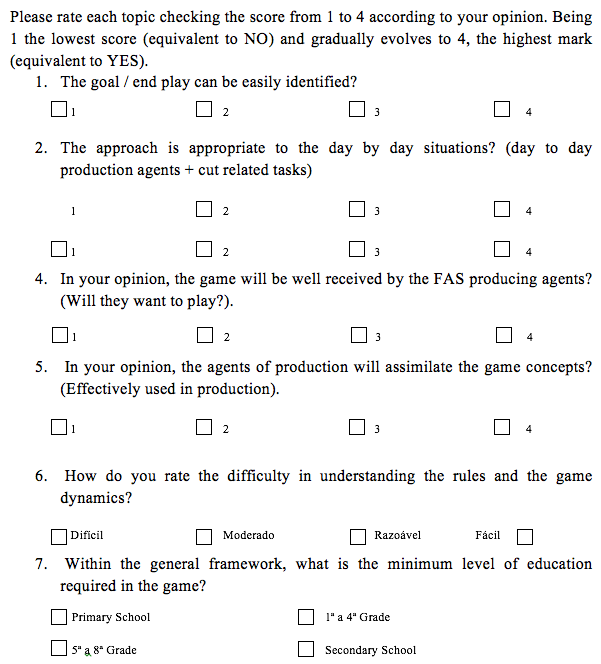

1. Departamento de Engenharia de Produção – DEP, Universidade Federal do Paraná – UFPR, Centro Politécnico s/n, Jardim das Américas, CEP 81531-980, Curitiba, PR, Brasil, e-mail: gustavo.bernardi.pereira@gmail.com
2. Programa de Pós-graduação em Engenharia de Produção - PPGEP, Universidade Federal do Paraná – UFPR, Centro Politécnico s/n, Jardim das Américas, CEP 81531-980, Curitiba, PR, Brasil, e-mail: adrianapls1@gmail.com